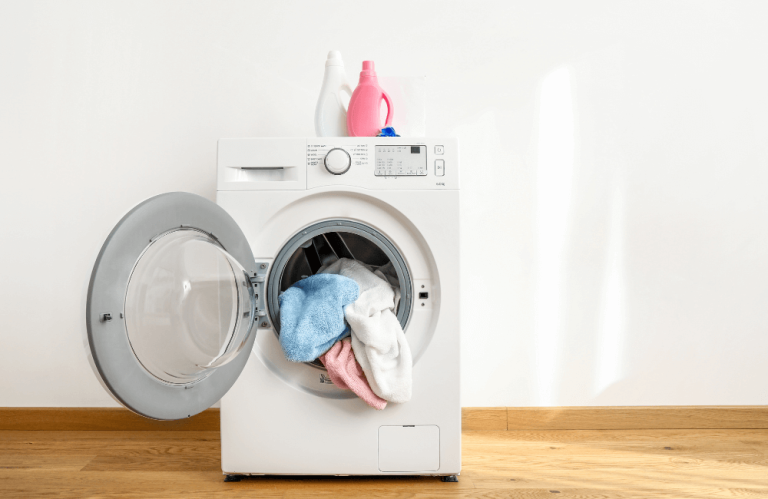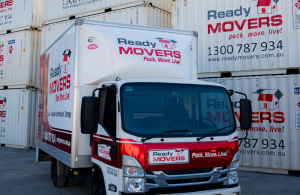Moving house requires moving some heavy, bulky items. One particularly hefty but also fragile item is your trusty household washing machine.
Most washing machines weigh at least 70kg, the weight of an adult person. They’re among the most difficult items to move due to delicate working parts that cause problems when damaged or loosened. Moving a washing machine is impossible on your own, difficult even for two people, and even harder when there are stairs involved. If the idea of your washing machine rattling along on a bumpy road strikes fear into your heart, you’re not alone.
Luckily, it’s possible to move any household item safely, including difficult and delicate items like washing machines, refrigerators, and dryers. Whether you have a front-loading or top-loading model, here’s the Ready Movers guide to everything you need to know about moving a washing machine.
What to Do When Moving a Washing Machine
Moving a washing machine is far from easy or fun, but there are steps you can take to ease the strain of this essential household item’s relocation.
Seek assistance
Moving a washing machine requires teamwork. If you don’t hire professional movers, make sure you have a couple of friends and family members who are up to the task.
Prepare your washing machine for the move
From draining the water to disconnecting the inlet hoses, there’s a lot to remember when getting your washing machine ready to move. Remove from the power source, remove any stray clothes, clean and dry out the drum, drain the hose (and pack it away safely) and empty the washer’s drain pipe.
Drain your washing machine before moving it
Draining a washing machine before moving isn’t just about making it lighter. If leftover water from your machine drips on the floor, it’s a safety hazard. Some front loaders have a waste area that you can open to let excess water out, but most of the time, you’ll just have to disconnect the hoses, lay them on the ground and let gravity assist you.
Read the owner’s manual
Consult your owner’s manual before you attempt to move your washing machine yourself. It might contain model-specific instructions to help you do the job safely.
Prepare the transit bolts
Some washing machines come equipped with ‘transit bolts’ that hold the drum in a fixed place to stop it from damaging the washer. These bolts will have been removed prior to actually using the washer, but you can reinstall them by placing one bolt in each of the four holes at the rear of the washer. Do you need transit bolts to move a washing machine? They are essential. Although the machine can be moved without them, it is at the owner’s risk. Forgoing these bolts definitely puts your machine at greater risk of damage.
Get a dolly
The staggering weight of most washing machines means that you need a dolly to safely move them. If you have to deal with stairs, a stair roller attachment can help you to adapt. Make sure you always have a spotter on hand to help you manage the dolly.
What Not To Do When Moving a Washing Machine
Some missteps can make an already difficult task even more difficult. Here are some mistakes to avoid when disconnecting and moving a washing machine.
Don’t go it alone
There are some things you should never attempt to do alone. Moving a washing machine is one of them, and that’s especially true if you have heart or back problems. Common mistakes include overestimating your own strength, forgetting to drain the water out or forgetting to unplug the machine, all of which can cause serious injury. If you’re wondering how to move a washing machine, the answer is never solo.
Don’t rush the job
Moving white goods requires care, precision and a considered approach. The more you rush the job, the higher the likelihood of making an error.
Don’t tilt the machine
Can you move a washing machine on its side when moving house? No, you shouldn’t. Washing machines contain mechanisms that can be damaged when tilted. Keep them upright as much as possible during the move, and if some tilting is unavoidable, leave your machine upright for at least 24 hours at your new place before plugging it in.
Don’t neglect protection
Make sure you use adequate protection for your machine, like padded blankets, to protect it during the move.
Troubleshooting: Common Issues When Moving a Washing Machine
Some pitfalls to anticipate and troubleshoot when shifting a washing machine from location to location include:
Transportation damage
Washing machines can be scratched, dented or damaged in other ways on a truck or trailer, especially if they’re not properly secured. Make sure you have the right equipment for the job, and give professional movers some serious consideration.
Water leaks
A machine that hasn’t been properly drained can leak water, creating an accident waiting to happen. That’s why draining a washing machine before moving it is always a non-negotiable part of the process.
Electrical issues
Make sure the power cord isn’t damaged after your move, and connect it properly to an electrical source. Moving electrical equipment without proper care exposes the plugs and cables to potential damage.
Levelling
Washing machines need to be level to work properly. Before operating your machine at your new destination, use a spirit level and adjust the feet if necessary.
Losing components
Make sure you keep the manuals, parts, accessories, and tools you’ll need to use your washing machine somewhere safe. Examples include transit bolts, installation equipment, and anything else you don’t want to get lost in the move.
Ventilation
If your machine is a washer-dryer combination, make sure the dryer’s ventilation hose is properly installed in your new location to prevent moisture build-up.
Stress-Free Home Removals with Ready Movers
Moving a washing machine doesn’t get any easier than using the Ready Movers home removalist services. Ready Movers offers a seamless and stress-free moving experience, whether you’re relocating locally or interstate, with professionals who know how to move a washing machine swiftly and efficiently. All of our packers are professionally trained in organising, boxing, and labelling your most treasured possessions. We can handle delicate and bulky items like washing machines and refrigerators with experience.
Ready Movers uses rail for all of our interstate furniture transport, so you won’t have to worry about your washing machine bouncing around on a rough road. A dedicated move manager is there every step of the way to make sure your move runs smoothly. Free in-home assessments, written quotes, fixed price rates (billed in volume, not hours), and full-cover insurance options available will take the stress out of your move.
Whether you want to know more about how to move a washing machine or you’re ready for your free moving quote, contact the Ready Movers team to find out more.







